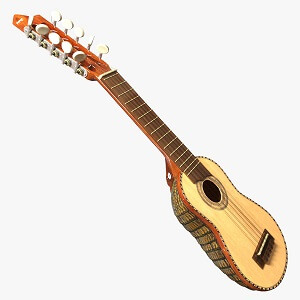Charango
 One of the most popular Andean musical instruments is a small guitar with five double strings that looks like a Spanish bandurria. If looked at from the front, there is nothing special, but when you turn it around, it is surprising. Its resonator, which is more or less rounded, is not made out of wood. It’s the shell of an animal!
One of the most popular Andean musical instruments is a small guitar with five double strings that looks like a Spanish bandurria. If looked at from the front, there is nothing special, but when you turn it around, it is surprising. Its resonator, which is more or less rounded, is not made out of wood. It’s the shell of an animal!
The charango is the Spanish guitar's little South-American brother. The instrument is thought to have originated some three hundred years ago in the "silver city" Potosi, in what is now Bolivia. It may have been devised by Indian musicians after the example of the guitars or mandolins of the Spanish conquistadors. The story goes that the indigenous musicians lacked the technology to shape a wooden soundbox, so they used the shell of an armadillo. The charango spread from the Potosi region along the major trade routes across much of the Andes, taking root in Bolivia, Peru and northern Argentina. It is still a favourite dance instrument, which is played both solo and in ensembles.
The charango is a strummed and plucked bowl-lute chordophone of the Andean regions of Bolivia, Peru, and Argentina. A ‘hybrid instrument’ influenced by both European and pre-Columbian musical cultures, the charango has for centuries been a part of the musical lives of indigenous Andean peoples such as the Quechua and Aymara. In this cultural context, it is played only by males and traditionally used for courting and to accompany festival dancing. Since the 1920s the charango has also come to be played by urban mestizo musicians as part of the music making associated with nationalist political movements and professional folkloric ensembles that concertize in urban settings in Andean countries and around the cosmopolitan world. The charango pictured here and described below is most likely associated with this latter domain, probably hailing from southern Peru.